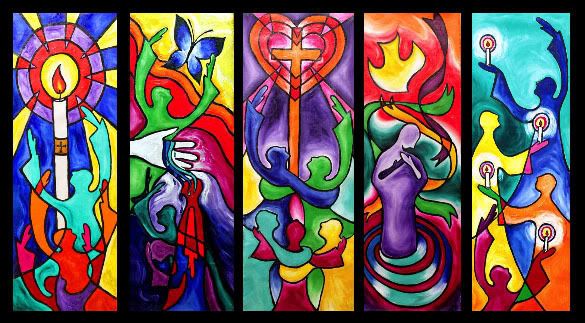A Sermon for the Transfiguration
February 3, 2008
Pastor Laura Gentry
Matthew 17:1-9
Six days later, Jesus took with him Peter and James and his brother John and led them up a high mountain, by themselves. And he was transfigured before them, and his face shone like the sun, and his clothes became dazzling white. Suddenly there appeared to them Moses and Elijah, talking with him. Then Peter said to Jesus, “Lord, it is good for us to be here; if you wish, I will make three dwellings here, one for you, one for Moses, and one for Elijah.” While he was still speaking, suddenly a bright cloud overshadowed them, and from the cloud a voice said, “This is my Son, the Beloved; with him I am well pleased; listen to him!” When the disciples heard this, they fell to the ground and were overcome by fear. But Jesus came and touched them, saying, “Get up and do not be afraid.” And when they looked up, they saw no one except Jesus himself alone. As they were coming down the mountain, Jesus ordered them, “Tell no one about the vision until after the Son of Man has been raised from the dead.” (NRSV)
Grace and peace to you from God our Father and from our Lord and Savior, Jesus Christ.
These days when you go to an internet movie discussion site, you often see the label “Warning: Contains Spoilers.” This means that the description of the film will give away the ending. So if you are planning to see the film and you don’t want to know what happens, then by all means, don’t read on. But sometimes, you want spoilers.
I remember some years back, I went to see a movie in the theatre with my husband. When the movie got to a tense and uncertain juncture, many of our fellow moviegoers were sobbing and sniffling. We could hear wet noses all around. William turned to me to see if I was alright. I admit it: I can sniffle with the best of them over a good drama. But this time, I was just fine. I wasn’t even a tad misty, much to his surprise. You see, a friend had already told me the spoiler so I knew that everything was going to be okay in the end—even though the movie’s plot was looking rather bleak. I could even handle the protagonist’s suffering.
Now today’s Gospel lesson really ought to have the warning label: “Contains Spoilers!” Because it gives us a glimpse at the resurrection—the end of the Jesus drama. The Transfiguration iis what I would call a spoiler, a divine ‘sneak preview’ to those disciples considered part of Jesus’ inner circle.
We know this story well. Jesus takes Peter, James and John up the mountain then then his face becomes radiant and his clothes a dazzling white. The images of Moses and Elijah appear in their midst and begin speaking with Jesus. Peter speaks up and mentions how it is good for them to be there and suggests creating three dwellings for the men. Immediately a cloud overtakes the men, from, which they hear a voice that informs the disciples that Jesus is God’s son and that the disciples are to listen to him. Shrinking in fear, the disciples fall with their faces to the ground. Moments later, Jesus bids them rise and the images of Elijah and Moses are gone. From there the four men descend the mountain and Jesus bids them not to speak of this incident to anyone until he has ascended to heaven.
The disciples have just received a preview, but what type of preview is it? The Transfiguration is another incident in which Jesus is arrayed as the Messiah, the anointed, the one sent to fulfill God’s plan of redemption for the world. The image of Jesus in heavenly splendor, his face radiant with the power of God and his clothes a remarkable white are precursors to the day of his ascension when, indeed, he will reside in heavenly splendor surrounded by the host of heaven. The images of Moses and Elijah are equally significant. Moses was set apart to present God’s law to the children of Israel. Moses himself had a transfiguring moment on top of Mt. Sinai when he spoke to God and received the tablets containing God’s law for Israel. Moses appears at the transfiguration representing the law of God, the Law that Jesus fulfills perfectly. The prophet Elijah appears as the greatest of the prophets signifying that Jesus fulfills the prophecies regarding the one to come. While Jesus is talking to with Moses and Elijah, presumably about the way in which he will make his transition to heaven, Peter enters in with his own talk.
Peter makes a suggestion that three dwellings be made for them. It is a suggestion that is virtually ignored by Jesus, but Matthew does not tell us why. Biblical scholars suggest that the dwellings that Peter might be referring to would be those maintained by the pagan religions of the day. Booths, shrines if you prefer, were placed in various places in, and around, Judea where people could go to make offerings to a particular god. Peter did not know how else to react to what he was witnessing. He sees a radiant Jesus accompanied by Moses and Elijah and his only response is, “we have to make this pay somehow, we have to make this last.” The suggestion to build three dwellings is Peter’s attempt at sustaining the glory of the transfiguration, as if he could contain the majesty portrayed in these three characters so people could come and make offerings on the mountaintop at will. In making this suggestion Peter was reducing Jesus to a pagan deity, hence Peter was ignored.
What we receive next is the resounding voice, presumably the voice of God, declaring that Jesus is the beloved son and we should pay him the attention. This voice comes deliberately because the mountaintop experience these men have observed is not going to last. The glory of the transfiguration is a preview of the future glory that we will all enjoy on the day of resurrection, but until then we must come down from the mountain and enter into the valley of death in the season of Lent.
We are heading towards Lent, a time to go inward, to really reflect upon our mortal condition, to focus upon the stuff we are made of—Lent is a time to make a solemn progression towards the cross of Christ, our cross. However, we know how the story ends. We know it doesn’t end with the cross of shame and death. We’ve seen the radiance of Jesus’ face, we’ve heard the voice of God—we can deal with Lent because we’ve already read the spoiler. It is precisely this preview of the ascended Jesus that gives us the strength to make it through the cross and beyond.
God did not have to provide this instance of the Transfiguration. God could have chosen to send us straight towards the cross with out any inclination of what lies in store. Even in light of the transfiguration, even in light of the glory of Easter we still see those who are hesitant—so caught up with the cross that they are stymied, unable to move for fear of suffering and death. Jesus has revealed just enough for us to know that although the way of the cross will be difficult, it will in no way be the end, but rather a door that we all must pass through before we are met on the other side, by Jesus. Even Jesus had to come down from the mountain. Transfigured as he was, in conversation with Moses and Elijah, glorified by God… even he had to enter into the suffering that was required to fulfill God’s plan of salvation.
Lent may not be our favorite liturgical season. We may not like the austere nature of Lent. The pains of our human condition may be disagreeable to our chosen interests, but remember this: each one of us goes into Lent with a preview of the coming attraction. God has not forsaken us. God has provided a beacon that will illumine the way ahead of us. It is the one preview that we find ourselves excited to see. We like what it has to offer us. May we enter into the season of Lent following Jesus' example of prayer and obedience. May we be transfigured by our acts of repentance and drawn closer to God than we’ve been in the past. Amen
Now, may the peace of God, which passes all understanding, keep our hearts and minds in Christ Jesus our Lord. Amen.
© 2008 Laura E. Gentry
Subscribe to:
Post Comments (Atom)








No comments:
Post a Comment